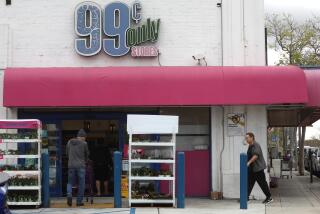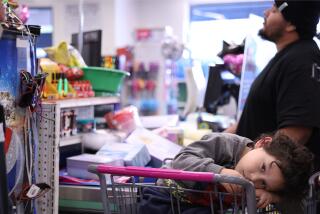The Coupon Gamble: Double or Nothing : Markets Bet on Customer Lures
Lucia Mendez was beaming Tuesday morning as she pushed her loaded cart out of the Ralphs grocery store in Culver City. The chain’s recent decision to offer “unlimited double coupons” had saved the housekeeper’s employers an estimated $10 on their bill.
“I didn’t know about it until I got here,” Mendez said as she loaded white plastic bags of groceries into her car. “So it was a nice surprise.”
With surveys showing that Ralphs’ shopper traffic has slipped since the end of last year, the Compton-based chain has reluctantly succumbed--at least temporarily--to a marketing gimmick that is a boon to customers and a bane of supermarkets: the doubling of an unlimited number of manufacturers’ cents-off coupons.
Double coupons certainly are not new to Southern California customers. But Ralphs’ decision--quickly followed by a similar pitch from Alpha Beta--marks a step-up in competition that makes the Southland turf even more of a free-for-all.
“This is just intensifying the battle with a little extra ammunition,” noted one longtime Southland supermarket observer.
For Ralphs, the program, first promoted in newspaper ads last Thursday, indicates a reversal of sorts. Although the chain has routinely offered customers the chance to redeem a limited number of coupons for double credit--say, two or three per shopping trip--its advertisements have long dismissed unlimited double coupons as a foolish idea that ends up costing customers in the form of higher shelf prices.
In particular, Ralphs’ ads criticized Vons, Hughes and Safeway, which have offered unlimited double coupons for months.
“We ran many price surveys comparing Ralphs against Vons, Hughes and Safeway,” said Al Marasca, executive vice president of marketing for Ralphs. “We found that stores that offered unlimited doubles also ran higher prices.” Last year, Marasca added, Ralphs ran several ads asking customers in effect: “Who really pays for unlimited double coupons? You guessed it. You do.”
Now, Ralphs is taking a new tack. “Our research . . . showed us that many of our customers might be going somewhere else because of unlimited coupons,” Marasca acknowledged. “So we decided, if that’s what they want, we’ll offer them that to get them back.”
Indeed, recent surveys by the Los Angeles Times’ Marketing Research department show that shopper traffic at Ralphs slipped in the first few months of 1987. For all of 1986, 18.8% of households questioned said they bought the majority of their groceries at Ralphs, making it the area’s leading food chain, ahead of Vons and Lucky. For the first two months of this year, Ralphs’ share slipped to 17.7% and then to 16.2% in March-April, when Vons secured the highly coveted lead position.
For Ralphs, such a move to unlimited double coupons would be dictated “from a defensive posture,” said John Walling, a vice president at A. C. Nielsen Co., a research firm in Northbrook, Ill.
Competitors agree. “We feel that Ralphs has reacted to a situation that was no longer tenable for them,” said Jack Ackroyd, director of advertising for the 43-store Hughes chain, which instituted unlimited double coupons about a year ago--after Vons and before Safeway. “In light of the fact that several chains were offering unlimited doubles,” he added, it’s a “good assumption” that the 112-store Ralphs chain was losing business.
To be sure, Ralphs’ competitive situation has been skewed by the entry of its new chain, the Giant warehouse stores, into the Southern California market. The company closed 16 nearby Ralphs stores as it opened the huge Giants in former Zodys locations last year.
In The Times’ marketing reports, the Giant stores captured a 5.1% share of shopper traffic for March-April. Competitors say the Giant stores are stealing business from other chains, notably Ralphs. (The unlimited double coupon promotion is not in effect at the Giant stores.)
Industry observers said the Giant stores also are not performing as well as Ralphs management had hoped. One executive at a competing chain who insisted on not being named said the stores need $1 million in sales each week to break even, but are averaging about $750,000.
As of Tuesday, Marasca said no decision had been made about how long Ralphs will continue the unlimited double coupon promotion. He would not reveal the chain’s cost so far of covering the half of the promotion not covered by the manufacturers but said it “has been offset by increased sales.”
“Our plan is to offer unlimited doubles and at the same time keep our lower prices and higher standards,” he said. “If we don’t get the increase in business to justify the program, we’ll discontinue it.”
To Ken Johnson, a Los Angeles-based supermarket consultant, the whole business doesn’t appear to mean much in the long run.
“We’ve been back and forth and back and forth (with unlimited double coupons),” he said. “I think it’s going to last for a while and then the chains will find what they already know: It’s a very expensive thing to do. Nobody really wins.”
Except the customers--maybe. Mendez, the gleeful housekeeper who unexpectedly saved a bundle, is already a regular Ralphs shopper. Ralphs acknowledges that it will need to attract a bevy of new shoppers to cover its costs.
“The only way that a chain can offer unlimited double coupons and not raise its prices,” Marasca said, “is if they experience a significant increase in sales.”
Lucky Stores, meanwhile, seems determined to stay above the couponing fray with continued emphasis on low prices. “There is an increase in activity with double-value coupons,” said Judith Decker, a spokeswoman for the Dublin, Calif.-based chain, “but that hasn’t changed our feeling that (low price) is still the right tool for Lucky.”
More to Read
Inside the business of entertainment
The Wide Shot brings you news, analysis and insights on everything from streaming wars to production — and what it all means for the future.
You may occasionally receive promotional content from the Los Angeles Times.











